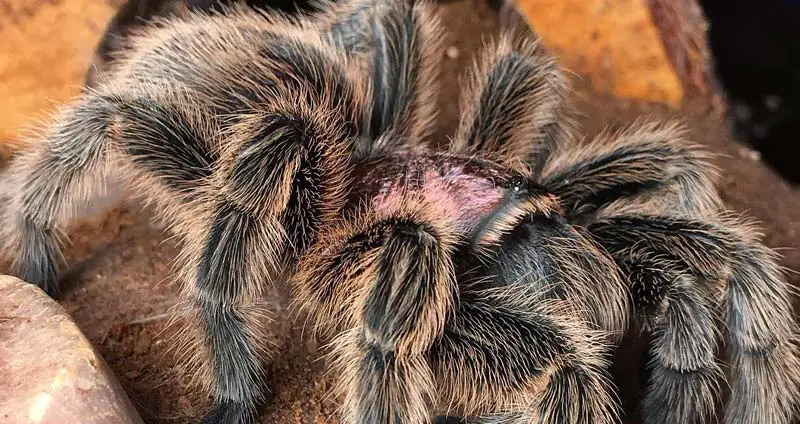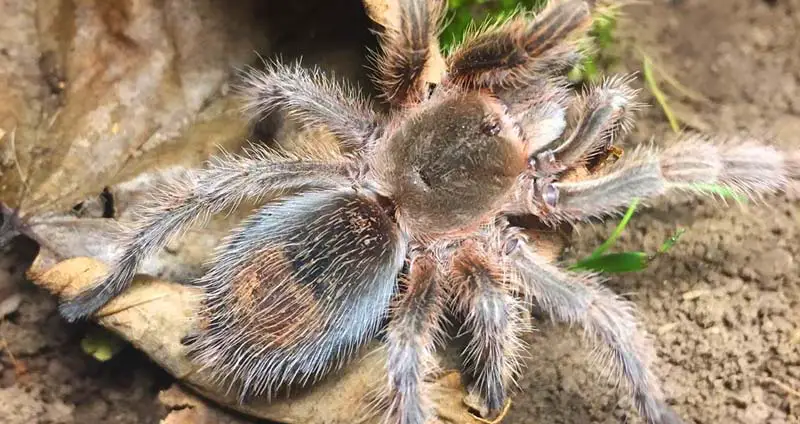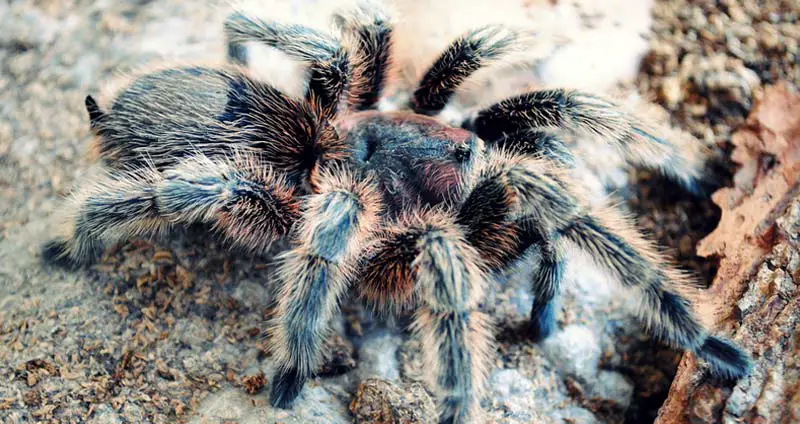Grammostola porteri, or the Chilean Rose Hair Tarantula, stands out among the 800+ tarantula species as one of the most popular tarantulas in existence.
If you were to ask an assortment of tarantula keepers what their first pet tarantula was, a large portion of them will immediately answer with this tarantula. Why is that?
This post will cover everything you need to know about Grammostola porteri, including how to house it, feed it, and care for it through its incredibly long lifespan.
Table of Contents
Grammostola porteri Care Sheet
Common Name | Chilean Rose Hair |
Species Type | New world terrestrial |
Habitat | Native to the scrublands of Argentina, Bolivia, and Chile where temperatures and humidities are consistently quite high. |
Growth Rate | Slow growth rate, taking many years to reach maturity. |
Adult Size | Females reach a legspan of about 6 inches, while males measure slightly smaller. |
Lifespan | Females regularly live between 20 and 30 years old, while males often only for 5. |
Enclosure | Their enclosure should be wider than it is tall with an emphasis on floor space. Six inches of substrate should line the floor, and a cork bark hide and water dish should also be present. |
Temp/Humidity | 75°F to 80°F with about 60% to 70% humidity. |
Diet | Great eater, but can sometimes go for long periods of time without eating. Adults can eat several adult crickets per week. |
Temperament | Typically an extremely docile and friendly tarantula that rarely, if ever throws threat poses or flicks hairs. Some specimen can be a bit unpredictable, though. |
Experience Level | Beginner – An extremely common beginner tarantula for a very good reason. It’s incredibly simply to keep this tarantula and they tend to be extremely friendly. |
Average Cost | Slings ~ $35, Males ~ $50, Females ~ $100+ |
Grammostola porteri vs. Grammostola rosea
First and foremost, a bit of confusion needs to be cleared. For years, people have been uncertain about the difference between Grammostola porteri and Grammostola rosea.
These species have frequently been confused to the point where the names are sometimes used interchangeably. This isn’t accurate, though. So what’s with the confusion?
When the Chilean Rose Hair tarantula was first brought into the pet trade, it had two color forms: red color form (RCF) and normal color form (NCF). Both of these were classified as Grammostola rosea.
However, as the taxonomy was studied closer over the years, it was eventually determined that these are two different species altogether!
The red color form would remain as Grammostola rosea while the normal color form would be identified as Grammostola porteri.
This is just one of the many reasons why scientific names are used in place of common names — there’s way too much confusion!
Grammostola porteri Appearance
In terms of appearance, this isn’t the most stunning tarantula that you’ll ever see. This is one reason why it can sometimes be overlooked by beginner owners.
Its appearance is more subtle and will definitely grow on you once you own it.
Grammostola porteri is a consistent grayish-brown color over their entire body, but they have a pinkish hue and markings on top of their carapace.
Long, white setae cover their bodies, giving them a fluffy and, frankly, adorable appearance that people absolutely love.
While average in looks, it’s also average in size. Adult females grow to be between 5″ and 6″, with males measuring slightly smaller. Where they differ, though, is their extremely slow growth rate.
Many Grammostola tarantulas have incredibly long lifespans, and this species is no exception. As females can live up to and beyond 30 years, they grow very slowly.
Due to this slow growth rate, if you’re purchasing a spiderling, be prepared to wait quite a long time before it reaches maturity.

Grammostola porteri Temperament
A large driving force behind the popularity of this tarantula species is its excellent temperament. Many enthusiasts are always on the lookout for friendly tarantulas, and G. porteri is definitely one.
First of all, this is a new world tarantula, which is a type of tarantula that’s known for its more docile nature, lack of aggression, and preference to run from danger as opposed to fighting it.
Many owners report that their tarantula is extremely docile and friendly towards them. They never act defensively or throw up threat poses, and flicking hairs is extremely rare.
There are some owners, though, that describe this species as sometimes feisty and unpredictable. As with any tarantula species, they do have the potential to possess any temperament.
Additionally, even if a tarantula is typically docile, its mood can change randomly. Environmental factors, its diet, and even molting can change change a tarantula’s temperament.
Within their enclosure, Grammostola porteri typically relaxes out in the open or down in their enclosure.
They aren’t incredibly active, but that means that they’re great display tarantulas.
Housing Grammostola porteri
Housing one of these tarantulas is very simple. They’re incredibly hardy and are fairly lenient in terms of the environment that they can be kept in.
As long as you supply your G. porteri with a good enclosure, accessorize it appropriately, and keep the internal climate consistent, it should be perfectly happy and healthy.
Optimal Enclosure
This is an average-sized terrestrial tarantula species, so its enclosure needs to reflect that.
The typical terrestrial tarantula enclosure has more of a focus on floor space than vertical height and allows for plenty of depth for burrowing. This is exactly what this species needs.
Two great Grammostola porteri enclosures are the Exo Terra 18″ × 18″ × 12″ terrarium and the Repti Zoo 20″ x 12″ x 10″ enclosure.
Both of these options are plenty large enough and are secure, breathable, accessible, and have great visibility.
Since this tarantula has such a long lifespan, it’s even more important to make sure that it’s comfortable and well taken care of.
Enclosure Decorations
It isn’t enough to just supply Grammostola porteri with a great enclosure. The inside of it needs to be optimally-designed, too.
Fortunately, as stated, this is a very hardy tarantula that only needs a few basic supplies in order to be comfortable and happy.
First and foremost, as this is a burrowing tarantula, you need to layer the bottom of the enclosure with about 6″ of moisture-retaining substrate. Coconut fiber substrate is great for this.
This substrate not only allows for G. porteri to burrow, but it also works to keep the enclosure clean and maintain humidity levels.
On top of the substrate, you need to include both a cork bark hide and a water dish. The hide will help to keep this species feeling calm and secure, and the water dish does wonders at preventing dehydration and contributing to humidity.
You can then round out the enclosure with sphagnum moss, fake plants, and some rocks and sticks.
Enclosure Temperature/Humidity
Grammostola porteri is endemic to the scrublands of Argentina, Bolivia, and Chile, where temperatures are decently warm and humid but nothing extreme.
Therefore, this species is best kept in the temperature range between 75°F and 80°F. Fortunately, for most people, this is right around room temperature — no extra effort needed.
If your tarantula’s enclosure consistently drops below this range, though, you may need to provide supplemental heating through either a space heater or a gentle heat lamp that doesn’t emit light.
Humidity levels are optimal right around 60% to 70%. This is fairly simple to maintain by keeping the water dish clean and filled and by misting down one side of the enclosure 2-3 times per week.
It’s recommended that you use a thermometer/hygrometer to monitor their environmental conditions so that you can make adjustments as needed.
Diet
This is a species that’s great at eating. That is… when it eats.
A quirky behavior of this species is it will sometimes go days, weeks, or even months without eating a single cricket. This is often the source of stress for many owners.
There are many reasons why a tarantula would stop eating for this long, but it’s mostly chalked up to them preparing for a molt.
As this species grows so slowly, it can prepare for a molt for around a year! So, if your Grammostola porteri refuses to eat, don’t stress and keep offering food at regular intervals until they eat again.
As spiderlings, flightless fruit flies and pinhead crickets can be fed twice a week, or as often as they’re willing to eat.
Mature tarantulas can eat around 5 large crickets every other week, and this can be supplemented with a dubia roach and some mealworms. This is a standard tarantula diet.
Be sure to remove any uneaten prey from the enclosure 24 hours after feeding, and avoid feeding for 2 weeks after a molt.
Health Concerns
Pet tarantulas in captivity almost never run into problems because of the good care that they receive. As long as their enclosure is optimal and their diet is complete, they’ll likely be very healthy.
Captive tarantulas can experience dehydration and mite infestations, but both of those problems are very easy to cure or just avoid altogether.
One thing to note about this species is that it loves to climb on the walls and ceiling of its enclosure, especially after a rehousing.
Because of this, it’s recommended that you don’t allow much space above it in it enclosure — just about six inches.
Additionally, be very careful when handling this tarantula. As it’s so docile, it is a prime candidate for occasionally being handled, but this could result in Grammostola porteri falling and potentially dying.
Grammostola porteri For Sale & Price
If you want to purchase this tarantula, I can’t blame you — it’s great. The easy care and agreeable personality of this species has made it an incredibly popular species.
Grammostola porteri spiderlings are available for sale on a variety of different websites and marketplaces for affordable prices. It’s common to find one for sale for around $35 with a safe-arrival guarantee.
Of course, there are several other costs of tarantula ownership that you’ll incur, but this is still a very affordable tarantula.
Overall, you’ll struggle to find a better tarantula — especially if you’re a beginner. Grammostola porteri is a pretty species that’s very easy to care for, lives an incredibly long time, and will be a joy to own from day one.

